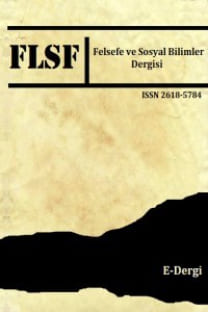MODERN FELSEFEDE ESTETİK ÇIKARSIZLIK KAVRAMININ GELİŞİMİ
Bu makalede estetik çıkarsızlık kavramının modern sanat felsefesindeki gelişimi incelenmektedir. Bu amaç doğrultusunda, ilk olarak, bu kavramın Kant’ta nasıl ele alındığı ve özgün anlamını kazandığı açıklanmaya çalışılacaktır. Ardından, Schopenhauer’ın estetik çıkarsızlık tartışmasına en önemli katkısı olan ve metafiziği ile birlikte ele alınacak olan beden temasına odaklanılacak ve beden ile estetik çıkarsızlık arasındaki ilişki görünür kılınmaya çalışılacaktır. Sonrasında ise, estetik çıkarsızlık kavramına dair, Nietzsche’nin düşüncesinde bu kavramın kısmi onaylanmasından, estetik deneyimde fizyolojinin vurgulanması ile bu kavramın eleştirisine doğru olan değişimi incelenecektir. Bu noktada, Schopenhauer’un estetik deneyimde bedenin rolüne dair yaptığı vurgu da göz önünde bulundurularak, estetik deneyimde bedenin işlevinin tam olarak Nietzsche’de geliştiği tartışılacaktır. Nietzsche’nin estetik çıkarsızlık hususunda değişen görüşlerini detaylandırmak için Apolloncu ve Diyonisosçu sanat dürtüleri, esrime Rausch ve son olarak yaşamın olumlanması ve yadsınması kavramları tartışılacaktır
Anahtar Kelimeler:
Sanat Felsefesi, Estetik Çıkarsızlık, Beden, Kant, Schopenhauer, Nietzsche
The Development of the Concept of Aesthetic Disinterestedness in Modern Philosophy
This article aims to investigate the development of the concept of aesthetic disinterestedness in modern philosophy of art. To this end, I firstly attempt to elucidate how this concept is described and gained its specific meaning in Kant’s philosophy. Then, by paying attention to his metaphysics, I lay stress on Schopenhauer’s pivotal contribution to the discussion of aesthetic disinterestedness, namely the body, and his attempt to bring into view the relation between the body and aesthetic disinterestedness. In the following, regarding the concept of disinterestedness, I enquire into how Nietzsche’s thought undergoes a shift from the partial approval of the concept to its criticism by emphasising the physiological aspect of aesthetic experience. Bearing in mind Schopenhauer’s emphasis on the role of the body, I argue that its function in aesthetic experience is fully developed in Nietzsche. To flesh out Nietzsche’s shift on the concept of disinterestedness, I examine the concepts of Apollinian and Dionysian art drives, Rausch, and lastly the affirmation and denial of life
Keywords:
Philosophy of Art, Aesthetic Disinterestedness, the Body, Kant, Schopenhauer, Nietzsche,
___
- BERGER, David (2009). Kant’s Aesthetics Theory: The Beautiful and Agreeable. Continuum, London and New York.
- DANIELS, Paul (2008), “Kant on the Beautiful: The Interest in Disinterestedness”, Colloquy Text Theory Critique, Issue: 16.
- GUYER, Paul (1996). Kant and the Experience of Freedom. Cambridge University Press, Cambridge.
- HAAR, Michel (2010). “Heidegger and the Nietzschean ‘Physiology of Art’”. Exceedingly Nietzsche: Aspects of Contemporary Nietzsche Interpretation. Edited by David Farrell Krell and David Wood. Routledge, London, New York, 13-30.
- HAMMERMEISTER, Kai (2002). The German Aesthetic Tradition. Cambridge University Press, Cambridge and New York.
- JACQUETTE, Dale (2007). “Schopenhauer’s Metaphysics of Appearance and Will in the Philosophy of Art”, Schopenhauer, Philosophy and the Arts. Edited by Dale Jacquette. Cambridge University Press, New York, 1-36.
- KANT, Immanuel (1987). Critique of Judgment. Translated by Werner S. Pluhar. Hackett, Indianapolis, Cambridge.
- MARSDEN, Jill (2002). After Nietzsche: Notes Towards a Philosophy of Ecstasy. Palgrave Macmillan, Basingstoke.
- NIETZSCHE, Friedrich (1967). The Birth of Tragedy. Translated by Walter Kaufmann. Vintage Books, New York.
- NIETZSCHE, Friedrich (1968). The Will to Power. Translated by Walter Kaufmann, R. J. Hollingdale. Vintage Books, New York.
- NIETZSCHE, Friedrich (1998). On the Genealogy of Morality. Translated by Maudemarie Clark, Alan J. Swensen. Hackett, Indianapolis, Cambridge.
- SALLIS, John (1988). “Dionysus – In Excess of Metaphysics”. Exceedingly Nietzsche. Edited by David Farrell Krell and David Wood. Routledge, London and New York.
- SALLIS, John (1991). Crossings: Nietzsche and the Space of Tragedy. The University of Chicago Press, Chicago and London.
- SCHACHT, Richard (2002). Nietzsche. Routledge, London and New York.
- SCHOPENHAUER, Arthur (1969). The World as Will and Representation: Volume I. Translated by E. F. J. Payne. Dover Publications, New York.
- STOLNITZ, Jerome (1961). “On the Origin of ‘Aesthetic Disinterestedness’”, The Journal of Aesthetics and Art Criticism, 20: 131-143.
- URPETH, Jim (2003). “Nietzsche and the Rapture of Aesthetic Disinterestedness: A Response to Heidegger”. Nietzsche and the German Tradition. Edited by Nicholas Martin. Peter Lang, Oxford, 215-236.
- WHITE, David A. (1973). “The Metaphysics of Disinterestedness: Shaftsbury and Kant”, The Journal of Aesthetics and Art Criticism, Vol. 32, No. 2.
- WOOD, Robert E. (1999). Placing Aesthetics: Reflections on the Philosophic Tradition. Ohio University Press, Athens.
- Yayın Aralığı: Yılda 2 Sayı
- Başlangıç: 2006
- Yayıncı: Hamdi BRAVO
Sayıdaki Diğer Makaleler
BİRİCİK VE MÜLKİYETİ’NDE BEN EGO KAVRAMI VE MODERN İNSAN TANIMININ DÖNÜŞÜMÜ
Cengiz Mesut TOSUN, Elif Can ÇAKIR
GERMAINE DE STAËL’IN FAİLLİĞİ VE FEMİNİST İLİŞKİSEL ÖZERKLiK ANLAYIŞI
TARİHSEL BİR DENEYİM OLARAK SANAT
DESCARTES VE HUME’DA “ŞÜPHELİ BİLGİ” FİKRİ
MODERN EPİSTEMOLOJİNİN TEMEL REFLEKSİYONU OLARAK YÖNTEMSEL DÜŞÜNMENİN ZEMİNİ
BİR ANTİ-DARWİNİST OLARAK NİETZSCHE
BEŞERİ COĞRAFYADA BİLİMSEL BİLGİ VE METODOLOJİK UYGULAMALAR ÜZERİNE BİR DEĞERLENDİRME
